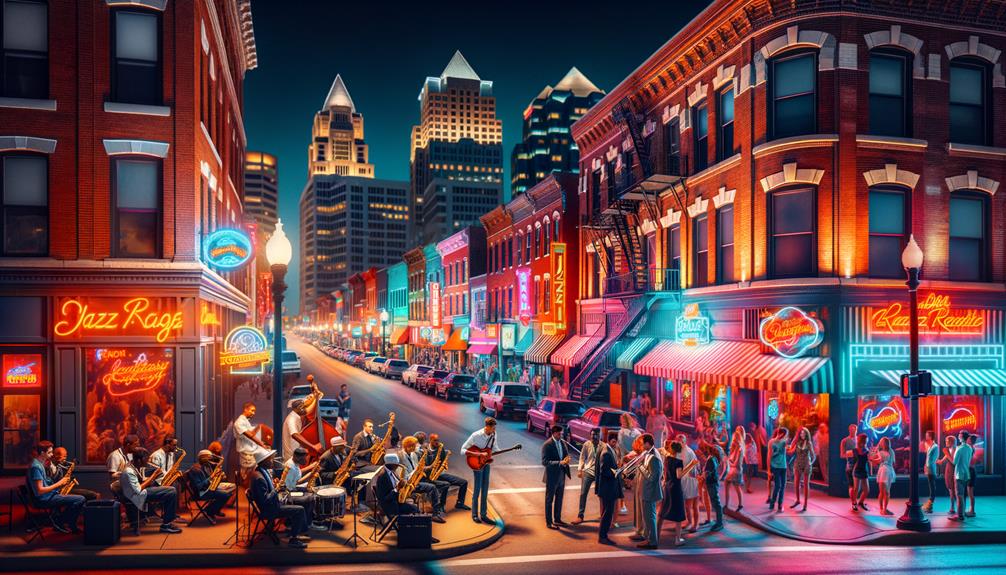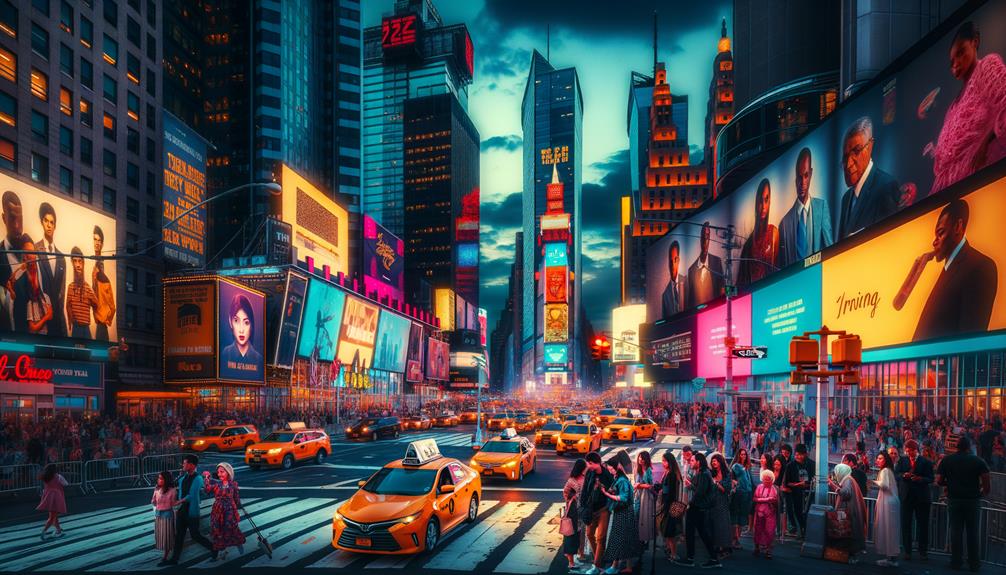As I wandered through the dimly lit corridors of the Blue Room, the echoes of a saxophone solo seemed to weave an intricate tapestry of Kansas City's rich history. The 18th & Vine District isn't just a neighborhood; it's a living museum where every corner whispers stories of resilience and cultural rebirth. From the soulful melodies reverberating through the Mutual Musicians Foundation to the reverent halls of the Negro Leagues Baseball Museum, the district pulses with a spirit that's both invigorating and contemplative. But what lies beyond the music and history?
History of 18th & Vine
Stepping into the 18th & Vine Historic District, you're surrounded by the rich history and culture of this vibrant Kansas City neighborhood. As you stroll through the district, the sounds of jazz fill the air, a reminder of the area's past as a hub for African-American music and life. Jazz legends once played in smoky clubs, their music becoming an integral part of American music history.
In this historic district, you'll find the Negro Leagues Baseball Museum, a tribute to the determination and talent of African-American baseball players who broke barriers and created their own league. The museum honors the spirit of a community that thrived despite segregation and exclusion. The Monarchs, the local Negro Leagues team, once called this area home, adding to the district's rich sports heritage.
Walking along Vine Street, you can sense the self-reliance that developed out of necessity when Black Kansas Citians were restricted south of 27th Street. The Kansas City Call newspaper, established in 1919, still operates here, chronicling the triumphs and struggles of this resilient community. It's a place where history is not just preserved but lived out every day.
Jazz Culture
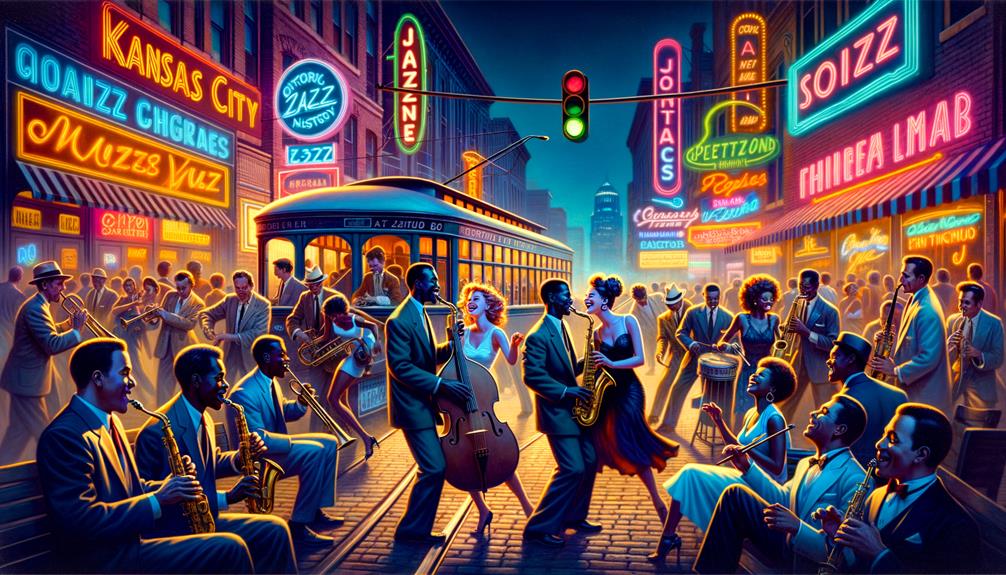
When I think of Kansas City's jazz culture, I'm transported to lively nights at iconic spots like the Blue Room and the Mutual Musicians Foundation. Kansas City jazz has evolved into a rich tapestry of soulful improvisations and spirited rhythms that filled the air in clubs and barbecue joints alike. This heritage still resonates through the district today, celebrated with enthusiasm at the 18th & Vine Heritage Jazz Festival.
Evolution of Kansas City Jazz
As I stroll through the historic 18th & Vine district, I can feel the echoes of Kansas City's jazz evolution, a cultural tapestry woven with the soulful rhythms of legendary musicians and the vibrant energy of bygone nights. This district is where Kansas City Jazz took root, blossoming into a unique sound that still resonates today.
The Mutual Musicians Foundation stands as a testament to the city's resilient jazz culture. It's a place where countless jazz legends honed their craft, creating a sound that defied convention. Walking through its halls, I can almost hear the improvisational brilliance that once filled the air.
To understand the evolution of Kansas City Jazz, you need to appreciate four key factors:
Kansas City's jazz sound was shaped by legendary musicians like Count Basie and Charlie Parker, who brought their own distinct styles to the table.
The Mutual Musicians Foundation played a crucial role in nurturing local talent and fostering a sense of community among musicians.
The vibrant nightlife of 18th & Vine was alive with clubs and joints that never slept, providing a platform for musicians to experiment and push boundaries.
Kansas City Jazz is a unique blend of local traditions and influences, which resulted in a sound that was both groundbreaking and deeply rooted in the city's culture.
Kansas City's jazz evolution is a living, breathing tribute to the freedom and creativity that defined an era. It's an ongoing legacy that continues to inspire new generations of musicians and music lovers alike.
Iconic Jazz Venues
Kansas City's vibrant jazz culture owes a great debt to two iconic venues: The Blue Room and the Historic Gem Theatre. These legendary spots have played host to some of the genre's most revered performers, and the energy of those epic nights still lingers in the air. As I stepped into The Blue Room, I could almost hear the echoes of Kansas City jazz legends like Charlie Parker and Count Basie. The walls seemed to vibrate with the soul of countless jam sessions.
The Historic Gem Theatre, with its stunning architecture and storied past, offers a majestic stage where jazz continues to flourish. This grand venue has seen it all, from impromptu performances to full-blown festivals.
At the heart of the Jazz District lies the 18th and Vine Heritage Jazz Festival, an event that celebrates the rich cultural heritage and history of the genre. This annual gathering draws enthusiasts from around the world, all united in their passion for jazz. Musicians Local #627, a cornerstone of this heritage, serves as a poignant reminder of the district's significance as a hub for African American artists.
Here's a glimpse into the cultural tapestry:
| Venue Name | Key Feature | Cultural Significance |
|---|---|---|
| The Blue Room | Intimate Jazz Club | Regular performances by local and international artists |
| Historic Gem Theatre | Historic Venue | Hosts major jazz events and festivals |
| Musicians Local #627 | Cultural Hub | Historical society preserving Kansas City's jazz heritage |
| 18th & Vine Jazz Fest | Annual Music Festival | Celebrates the legacy and future of Kansas City Jazz |
Each of these venues and events weaves a rich narrative that continues to shape the Jazz District's identity.
Key Attractions
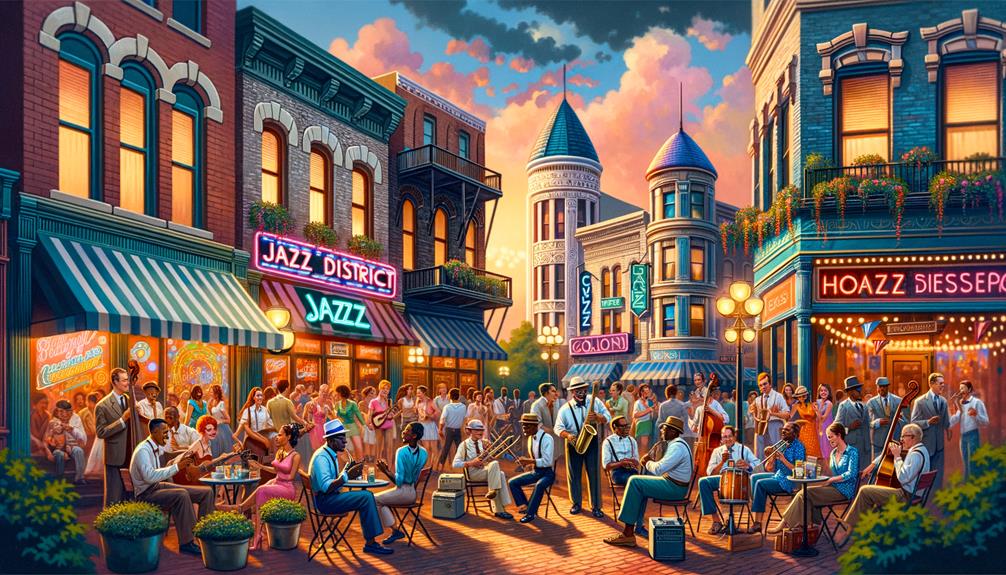
As I strolled through the Kansas City Jazz District, the historic jazz venues, like The Blue Room and the Historic Gem Theatre, transported me to a bygone era, their walls resonating with the soulful sounds of the past. The American Jazz Museum and Negro Leagues Baseball Museum offered a deeper understanding of the district's rich African American heritage. And, of course, the iconic barbecue joints tantalized my senses, completing this vibrant cultural tapestry.
Historic Jazz Venues
Wandering through the Historic Jazz District, you'll find yourself enchanted by iconic venues like the Blue Room and the Gem Theatre, each echoing the soulful melodies that once defined Kansas City's legendary jazz scene. The Blue Room, situated within the American Jazz Museum, is more than just a venue – it's a living tribute to jazz legends. The walls resonate with the spirit of past performances, creating an intimate atmosphere that transports you back to jazz's golden era.
A short stroll brings you to the Gem Theatre, a grand venue with a beautifully restored façade that has hosted countless legendary performers. This historic theatre has seen it all, from jazz greats to modern-day musicians, and continues to thrive as a hub for jazz innovation.
To truly appreciate the district, consider visiting these must-see sites:
- American Jazz Museum – Explore the stories behind the music and get an in-depth look at the history of jazz.
- Negro Leagues Baseball Museum – Learn about the intersection of sports and African American history, and how it impacted the jazz scene.
- Musicians Local #627 – Celebrate the union that supported countless jazz careers and helped shape the genre.
- Black Archives of Mid America – Delve into the broader cultural contributions of African Americans and their impact on jazz.
Each venue in the Historic Jazz District offers a unique chapter in Kansas City's rich cultural tapestry, inviting you to experience the freedom and soul of jazz.
Cultural Museums
Stepping into the vibrant Kansas City Jazz District, you're surrounded by cultural museums that celebrate the soul and legacy of jazz and African American heritage. The American Jazz Museum is a hub of Kansas City Jazz, drawing you in with its engaging exhibits and live performances. Every corner of this museum pulses with the rhythms of legends like Charlie Parker and Duke Ellington, offering an interactive journey through the history and evolution of jazz.
Just a short walk away, the Negro Leagues Baseball Museum pays powerful tribute to African American baseball players. Here, the stories of trailblazers who fought for their rightful place in America's pastime come alive. The museum's displays and artifacts paint a moving picture of resilience and triumph, making it a must-visit cultural attraction.
Nearby, Musicians Local #627 offers a unique glimpse into the golden era of Kansas City Jazz. This historic union hall highlights the influence of local musicians who shaped the soundscape of jazz. Together, these museums provide profound insight into the African American experience, making the Kansas City Jazz District a treasure trove of cultural history.
Iconic Barbecue Joints
The mouthwatering aroma of smoked meats fills the Kansas City Jazz District, drawing you to the legendary barbecue joints of Gates and Arthur Bryant's. These iconic spots are more than just restaurants – they're a part of history where African American pitmasters have perfected the art of barbecue over time. Walking into Gates, you're greeted with a warm welcome that feels as familiar as the jazz rhythms echoing through the district.
Arthur Bryant's, on the other hand, exudes a rustic charm, with walls adorned with photos of jazz legends who've dined there. Despite facing racism, the pitmasters at both joints have crafted recipes that have stood the test of time. Their dedication to their craft has resulted in smoked meats that are simply legendary.
What makes these places special is:
They're community-owned, providing a prejudice-free dining experience.
They're deeply rooted in jazz culture, frequented by musicians who've shaped the district's cultural identity.
The pitmasters use fresh meat and traditional techniques, honing their craft over the years.
These establishments have endured despite challenges, leaving a lasting legacy.
In the Kansas City Jazz District, the barbecue is more than just food – it's a symbol of freedom and community.
Culinary Scene
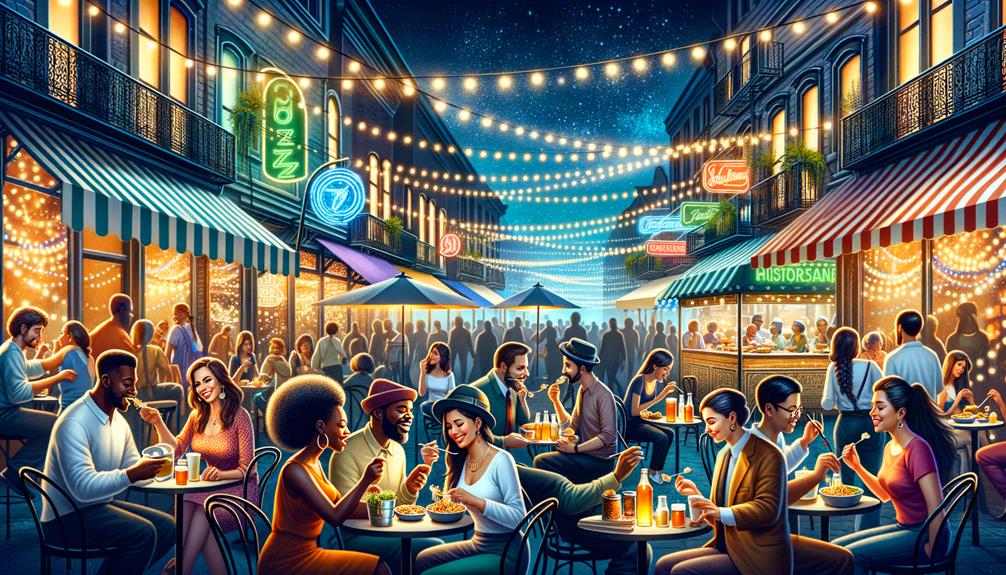
In Kansas City's Jazz District, the culinary scene is alive with the rich, smoky aromas of barbecue, where legendary spots like Gates and Arthur Bryants offer more than just meals – they serve up a taste of history and community. When you walk into these establishments, you can't help but feel enveloped by the warmth of tradition and the tantalizing scent of smoked meats. African American pitmasters, with access to the freshest cuts, have perfected their craft over generations, turning barbecue into a culinary art form that speaks to resilience and creativity.
These barbecue joints are more than just eateries – they're cultural hubs. At Gates, the friendly staff greet everyone with a warm welcome, creating an inclusive atmosphere that's free of prejudice. Arthur Bryants' walls are adorned with memorabilia, telling stories of jazz musicians and locals who have frequented its tables over the years. Each bite of tangy, savory barbecue is a tribute to the thriving black culture that has endured adversity.
The culinary scene here is a vibrant tapestry, woven together with the smoky threads of smoked meats and the indomitable spirit of the African American community. It's a feast for both the senses and the soul, offering a taste of the city's rich cultural heritage.
Redevelopment Efforts
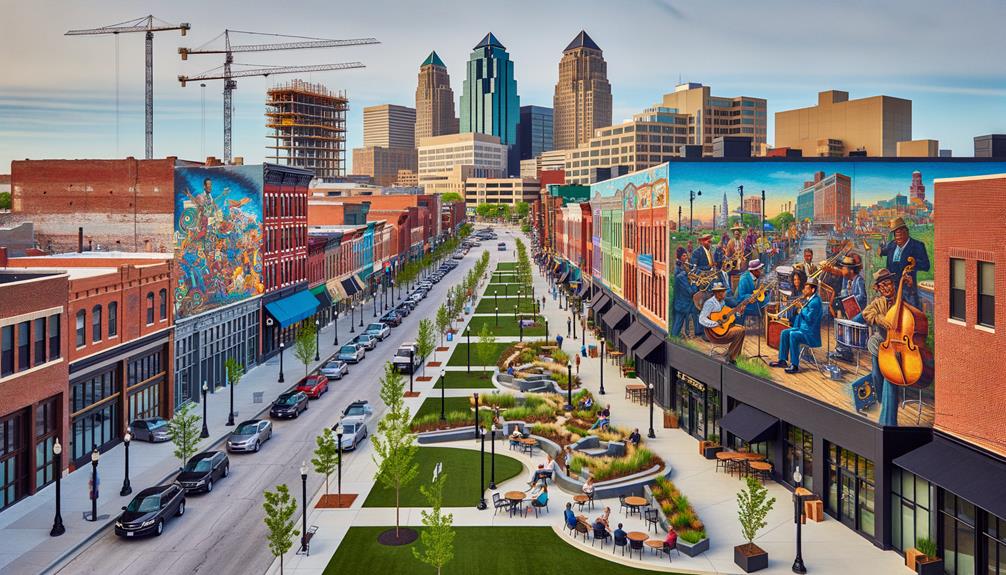
Kansas City's Jazz District has undergone a remarkable transformation, thanks to the dedicated efforts of organizations like the Black Economic Union and the Jazz District Redevelopment Corporation. These groups have worked tirelessly to breathe new life into the district, allocating funds for renovation and revitalization under the Cleaver Plan.
As I walk through the district, I'm struck by the seamless blend of history and modernity. The American Jazz Museum and the Negro Leagues Baseball Museum stand as pillars of cultural heritage, celebrating the rich legacy of African American achievements in music and sports.
The redevelopment efforts have focused on several key areas. Historic buildings have been repurposed for new businesses and affordable housing, preserving the district's architectural charm. Green practices ensure that the revitalization efforts are environmentally conscious. Museums and cultural centers nurture a deep connection to the district's history. New businesses and residential projects stimulate the local economy.
Every corner of the Jazz District hums with a renewed sense of purpose. It's a place where the past meets the present, setting the stage for a thriving future.
Future Prospects
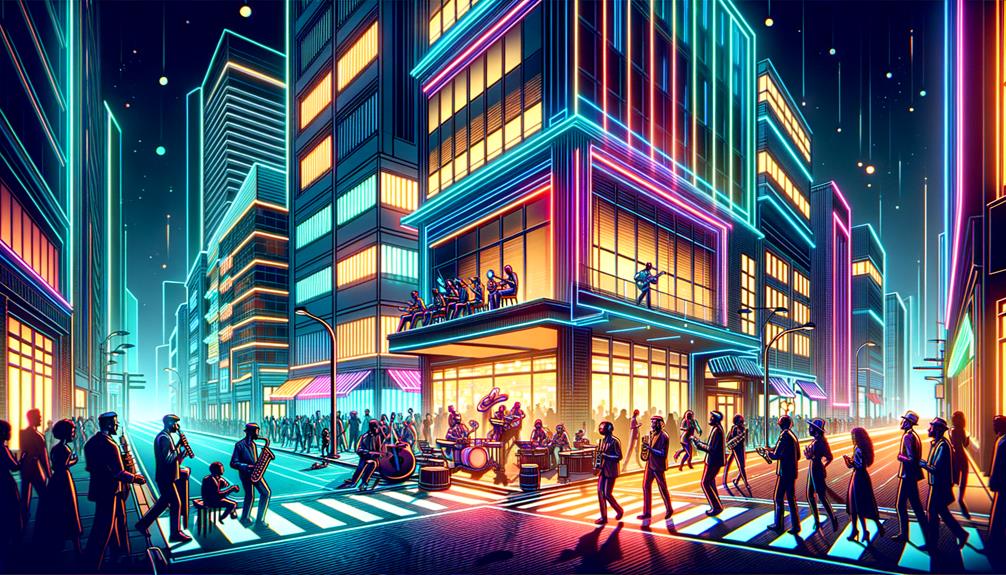
As I look to the future, I'm excited about the prospects of the Kansas City Jazz District. The area is on the cusp of a rebirth, with historic preservation assessments underway for iconic landmarks like the Attucks School and the Eblon Theater. These efforts aren't just about saving old buildings; they're about preserving the heart and soul of the area, honoring its cultural legacy in a way that resonates with both locals and visitors.
Redevelopment plans aim to revitalize the district, recapturing the energy of the Jazz Era. The vision includes building new residential units, commercial spaces, and entertainment venues, creating a dynamic mix of living, working, and playing. Partnerships with organizations like the Ewing M. Kauffman Foundation and IDEO are crucial in striking a balance between cultural and economic growth.
Sustainability is at the core of these efforts, ensuring the district evolves without losing its unique character. As the Kansas City Jazz District continues to grow, it promises to remain a top destination, offering one-of-a-kind cultural attractions and entertainment options. This growth honors the past while looking forward to a bright future.

